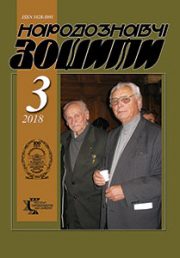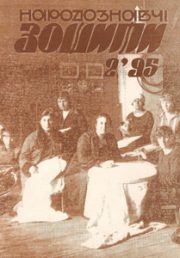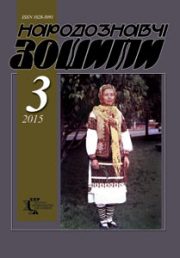The Ethnology Notebooks. 2018, 1 (139), 138–149
UDK 726.54:745.51.02](477)
DOI https://doi.org/10.15407/nz2018.01.138
Received 26.12.2017
ORCID ID: https://orcid.org/0000-0002-0512-6388
Boliuk Oleh, Candidate of Sciences in Art Studies,
Ph.D, doctoral student in the Folk Art Department
of the Institute of Ethnology of the National Academy of Sciences of Ukraine.
Svobody Avenue 15, 79000, Lviv, Ukraine.
Contacts: e-mail: oleh.bolyuk@gmail.com
Abstract. The answers to the questions on the basic concepts necessary for the scientific cognition of the phenomenon of the church artistic wood are presented. The key theoretical toolkit for research is the method, approach and principle. An attempt is made to determine their universal definition, where there is no possibility of substitution of one value for another. In some examples, a functional projection of methodological tools for studying the wooden equipment of Ukrainian churches is considered.
Keywords: method, approach, principle, phenomenon, artistic wood, church, Ukraine.
REFERENCES
Boliuk, O. (2016). Derev’iane oblashtuvannia tserkov Pokuttia: topohrafiia ozdoblennia ta stylevi inspiratsii (za materialamy ekspedytsij). Pravoslav’ia v Ukraini: Zbirnyk materialiv VI Mizhnarodnoi naukovoi konferentsii, prysviachenoi 1000-littiu dukhovnykh zv’iazkiv Ukrainy z Afonom (1016–2016) ta 25-littiu Pomisnoho Soboru Ukrains’koi Pravoslavnoi Tserkvy (1–3 lystopada 1991 r.). Kyiv: Kyivs’ka pravoslavna bohoslovs’ka akademiia. P. 610–619.
Boliuk, O. (2011). Sviatylysche tserkvy vs presviterium kostelu: spil’ne ta vidminne derev’ianoho oblashtuvannia. Ukraina – Vatykan: problemy derzhavno-tserkovnykh vzaiemyn u konteksti dosvidu ob’iednanoi Yevropy. Materialy V Mizhnarodnoi naukovoi konferentsii 26—28 travnia 2011 r., m. Halych (2 zoshyt). Halych: Informatsijno-vydavnychyj viddil Natsional’noho zapovidnyka «Davnij Halych». P. 120–129.
Boliuk, O. (2010). Systema statsionarnoho derev’ianoho obladnannia sviatylyscha: roztashuvannia, funktsiia, tektonika, symvolika. Istoriia relihij v Ukraini: Naukovyj schorichnyk (Kn. II). L’viv: Lohos. P. 580–588.
Veber, M. (1994). Protestants’ka etyka i dukh kapitalizmu. Kyiv: Osnovy.
Zakharova, A.L. (2004). Poetyka khramu u tvorakh khudozhn’oi literatury (na materiali romaniv U. Holdinha «Shpyl’» i Yu. Misimy «Zolotyj khram»): avtoref. dys. … na zdobuttia stupenia kandydata filolohichnykh nauk: 10.01.06; Donets’kyj natsio-nal’nyj universytet. Donets’k.
Krvavych, D. (2003). Universalizm dyzajnu iak mystetstva idei, formy ta funktsii (na prykladi mystetstva skul’ptury). Akadem-dyzajn: Visnyk Ukrains’koi akademii dyzajnu. L’viv. № 1. P. 126–144.
Mykhajlova, R. (2005). Metod doslidzhennia u mystetstvoznavstvi za robotamy V.P. Petrova-Domontovycha. Visnyk Kyivs’koho natsional’noho universytetu imeni Tarasa Shevchenka. P. 31–34.
Konvers’kyj, A.Ye. (Ed.). (2010). Osnovy metodolohii ta orhanizatsii naukovykh doslidzhen’: Navchal’nyj posibnyk. Kyiv: Tsentr uchbovoi literatury.
Stankevych, M. (2015). «Neistoriia mystetstva»: formuliuvannia naukovoi problemy». Teoriia ramy: vybrani pratsi z istorii ta teorii mystetstva. L’viv: Spilka krytykiv ta istorykiv mystetstva. P. 79–91.
Fedorchuk, O. (2017). Kontseptsiia etnichnoi mystets’koi tradytsii bisernoho ozdoblennia narodnoi noshi ukraintsiv (Chastyna 1). Narodoznavchi zoshyty. №. 3. P. 571–572.
Бастун, М.В. Культорологічний підхід в освіті та його психолого-педагогічне значення. URL: http://lib.iitta.gov.ua/6594/1/Bastun_6.pdf.
Boliuk, O. Kontseptsiia vyvchennia tserkovnykh khudozhnikh tvoriv z dereva: teoretychni pidkhody ta praktychni rekomendatsii. Hlobalizatsiia/ievropeizatsiia i rozvytok natsio-nal’nykh slov’ians’kykh kul’tur: materialy konferentsii. URL: http://conference.nbuv.gov.ua/report/view/id/740 =. (17.05.2016).
Bujs’kykh, Yu., Sobolieva, O. Chomu kraini potribni antropolohy? Uriadovyj kur’ier. Hazeta Kabinetu Ministriv Ukrainy. URL: https://ukurier.gov.ua/uk/articles/chomu-krayini-potribni-antropologi/ (16.12.2017).
Burd’io, P. (1994). Nachala. Choses dites. Moskva: Socio-Logos. URL: http://bourdieu.name/content/kodifikacija.
Gumiljov, L. Jetnogenez i biosfera Zemli. URL: https://www.e-reading.club/chapter.php/17542/155/Gumilev_-_Etnogenez_i_biosfera_Zemli.html; https://www.e-reading.club/chapter.php/17542/157/Gumilev_-_Etnogenez_i_biosfera_Zemli.html (18.04.2008).
Lidov, A. Ierotopija. Sozdanie sakral’nyh prostranstv kak vid hudozhestvennogo tvorchestva. URL: http://www.polit.ru/article/2007/06/14/ierotop (14.06.2007).
Lychkovakh, V. Sakral’ni horyzonty ukrains’koi kul’tury. Arkhetypy – khronotopy – syhnatury. URL: https://www.filosof.com.ua/Mentaltheorie/P12.pdf (16.07.2010).
Metodolohiia nauky. URL: https://uk.wikipedia.org/wiki/%D0%9C%D0%B5%D1%82%D0%BE%D0%B4%D0%BE%D0%BB%D0%BE%D0%B3%D1%96%D1%8F_%D0%BD%D0%B0%D1%83%D0%BA%D0%B8 (12.07.2017).
Nesterenko, H. (2005). Prymordialists’ki ta modernists’ki teorii natsii: superechlyvist’ chy konstruktyvne vzaiemodopovnennia. Kul’turolohichnyj visnyk Nyzhn’oi Naddniprianschyny. P. 156–164. URL: http://irbis-nbuv.gov.ua/cgi-bin/irbis_nbuv/cgiirbis_64.exe?C21COM=2&I21DBN=UJRN&P21DBN=UJRN&IMAGE_FILE_DOWNLOAD=1&Image_file_name=PDF/Kultv_2005_15_25.pdf.
Pazenok, V.S.(2008). Filosofiia: Naukovyj posibnyk. Kyiv: Akademvydav.
Scherba, S.P., Schedrin, V.K., Zahlada, O.A. (2004). Filosofiia: Navchal’nyj posib-nyk. Kyiv: MAUP.
Scherba, S.P., Zahlada, O.A. Filosofiia: pidruchnyk. URL: http://westudents.com.ua/glavy/95259-2-ponyattya-metoda-y-metodolog.html (14.12.2017).






